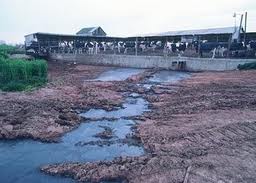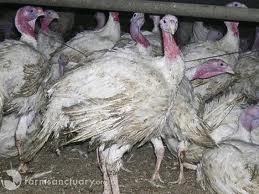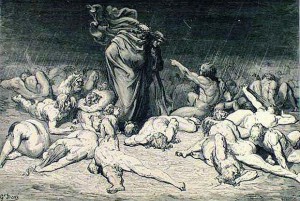“Be the change you want to see in the world” Mahatma Gandhi
It is convenient to categorize veganism as a response to animal suffering or a  health fad. But, faced with the true figures, it seems plain that it is the only ethical choice to what is arguably the world’s most urgent environmental and social justice issue. Gluttony and greed are stripping the planet of vital resources and polluting what left of them.
health fad. But, faced with the true figures, it seems plain that it is the only ethical choice to what is arguably the world’s most urgent environmental and social justice issue. Gluttony and greed are stripping the planet of vital resources and polluting what left of them.
Famine can only be avoided we give up meat, fish and dairy.
The Christians stole the winter solstice from the pagans, and capitalism stole it from the Christians. But one feature
of the celebrations has remained unchanged: the consumption of vast quantities of meat. The practice used to make sense. Livestock slaughtered in the autumn, before the grass ran out, would be about to decay, and fat-starved people would have to survive a further three months. Today we face the opposite problem: we spend the next three months trying to work it off.
Someday, our unsustainable gluttony will be deemed the worse offending crime against humanity (notwithstanding the day in and day after torturous treatment of farm animals).
“Those who claim to care about the well-being of human beings and the preservation of our environment should become vegetarians for that reason alone. They would thereby increase the amount of grain available to feed people elsewhere, reduce pollution, save water and energy, and cease contributing to the clearing of forests.… When non-vegetarians say that ‘human problems come first’ I cannot help wondering what exactly it is that they are doing for human beings that compels them to continue to support the wasteful, ruthless exploitation of farm animals.” Peter Singer

This is why biotechnology – whose promoters claim that it will feed the world – has been deployed to produce not food but feed: it allows farmers to switch from grains which keep people alive to the production of more lucrative crops for livestock. Within as little as 10 years, the world will be faced with a choice: arable farming either continues to feed the world’s animals or it continues to feed the world’s people. It cannot do both.
The impending crisis will be accelerated by the depletion of both phosphate fertilizer and the water used to grow crops. Aquifers are beginning the run dry all over the world, largely because of animal farming.
World hunger is increasing at a rate of 4 million a year. If all the farm produce that is used to feed animals was used to feed people a vegetarian diet then no one in the world would need to be hungry.
In 2006 the United Nations Food and Agriculture Organization published the following report:
Climate change: With rising temperatures, rising sea levels, melting ice caps and glaciers, shifting ocean currents and weather patterns, climate change is the most serious challenge facing the human race. The livestock sector is a major player, responsible for 18 percent of greenhouse gas emissions measured in CO2 equivalent.… Livestock are also responsible for almost two-thirds (64 percent) of anthropogenic ammonia emissions, which contribute significantly to acid rain and acidification of ecosystems
 Water: The livestock sector is a key player in increasing water use, accounting for over 8 percent of global human water use, mostly for the irrigation of feed crops. It is probably the largest sectoral source of water pollution, contributing to “dead” zones in coastal areas, degradation of coral reefs, human health problems, emergence of antibiotic resistance and many others. The major sources of pollution are from animal wastes, antibiotics and hormones, chemicals from tanneries, fertilizers and pesticides used for feed crops, and sediments from eroded pastures.
Water: The livestock sector is a key player in increasing water use, accounting for over 8 percent of global human water use, mostly for the irrigation of feed crops. It is probably the largest sectoral source of water pollution, contributing to “dead” zones in coastal areas, degradation of coral reefs, human health problems, emergence of antibiotic resistance and many others. The major sources of pollution are from animal wastes, antibiotics and hormones, chemicals from tanneries, fertilizers and pesticides used for feed crops, and sediments from eroded pastures.
Land degradation: Expansion of livestock production is a key factor in deforestation, especially in Latin America where the greatest amount of deforestation is occurring – 70 percent of previous forested land in the Amazon is occupied by pastures, and feedcrops cover a large part of the remainder………………………..
The Natural Resources Defense Council warns:
On factory farms, animals are highly confined into relatively small areas; their manure and urine are funneled into
massive waste lagoons. These cesspools often break, leak or overflow, sending dangerous microbes, nitrate pollution and drug-resistant bacteria into water supplies. Factory-farm lagoons also emit toxic gases such as ammonia, hydrogen sulfide and methane. What’s more, the farms often spray the manure onto land, ostensibly as fertilizer — these “sprayfields” bring still more of these harmful substances into our air and water.
To produce one pound of wheat takes about 25 gallons of water and a lot of sun. Yet 16 pounds of that wheat (plus soy) and 2,500 gallons of water fed to a cow to make one pound of beef. More than half our farmland and half our water consumption is currently devoted to the meat industry
Shawn Dell Joyce writes that it takes one sixth of an acre of land to produce enough food for a vegan but more than three acres to feed a meat eater. That is a factor of 18! But according to the British group Vegfam. A 10-acre farm could feed 60 people growing soybeans, 24 people growing wheat, 10 people growing corn but only two producing cattle. That is more like a factor of 30!
We eat most of our grain in the form of meat, 90 percent actually, which translates into 2,000 pounds of grain a year
“The way that we breed animals for food is a threat to the planet. It pollutes our environment while consuming huge amounts of water, grain, petroleum, pesticides and drugs. The results are disastrous.”
David Brubaker, PhD, Center for a Livable Future, Johns Hopkins University
The meal plan of the average American family accounts for 2.8 tons of CO2 emitted annually, compared with 2.2 tons for driving. Worldwide agriculture contributes some 30% of global greenhouse-gas emissions, far more than transportation. So when it comes to cutting your carbon footprint today, the truth is that what you eat is as important as what you drive. “If you can’t buy a Prius,” says Jonathan Kaplan of the Natural Resources Defense Council, “you can certainly eat like one.”
Many of those who have begun to understand the death sentence of global grain production have responded by becoming vegetarians. But vegetarians who continue to consume milk and eggs scarcely reduce their impact on the ecosystem and contribute to intense suffering of dairy cows and chickens.
The conversion efficiency of dairy and egg production is generally better than meat rearing, but even if everyone who now eats beef were to eat cheese instead, this would merely delay the global famine and offer no answer to animal suffering.
As both dairy cattle and poultry are often fed with fishmeal and ground up animal parts (which means that no one can claim to eat cheese but not fish or animals), it might, in one respect, even accelerate it.
The shift would be accompanied too by a massive deterioration in animal welfare: with the possible exception of intensively reared broilers and pigs, battery chickens and dairy cows who already suffer the most and whose tortured existence cannot get much worse.
We can eat fish, but only if we are prepared to contribute to the collapse of marine ecosystems, with many species of fish on the brink of extinction, like Blue Fin Tuna, the killing and maiming of hundreds of thousands of dolphins accidentally caught in nets (except in Japan where they are killed for meat) and – as the Europeans, Americans and developing countries plunders the seas – the starvation of some of the hungriest people on earth is imminent.
Our seasonal excesses would be perfectly sustainable, if we weren’t doing the same thing every week of the year. But, because of the rich world’s disproportionate purchasing power, many of us can feast every day. By comparison to most of the animals we eat, turkeys are relatively efficient converters: they produce about three times as much meat per pound of grain as feedlot cattle. But there are still plenty of reasons to feel uncomfortable about eating them.  Most are reared in darkness, so tightly packed that they can scarcely move. Their beaks and their back toe are removed with a hot knife without anesthetics to prevent them from hurting each other. As Thanksgiving or Christmas approaches, they become so heavy that their hips buckle. Supposedly stunned but in reality often still fully conscious and flapping their wings, they are hung upside down on a conveyer, their throat is cut by the automated blade, but the blade misses many of the struggling birds and often they are still alive when dropped into the scalding water.
Most are reared in darkness, so tightly packed that they can scarcely move. Their beaks and their back toe are removed with a hot knife without anesthetics to prevent them from hurting each other. As Thanksgiving or Christmas approaches, they become so heavy that their hips buckle. Supposedly stunned but in reality often still fully conscious and flapping their wings, they are hung upside down on a conveyer, their throat is cut by the automated blade, but the blade misses many of the struggling birds and often they are still alive when dropped into the scalding water.
When you see the inside of a turkey broiler house, you begin to entertain grave doubts about Western civilization.
Beware! The “Free Range” label is a deceitful lie and ” Natural” and “Organic” labels only refer to the feed, nothing to do with the treatment of the animals. Only Farms with the “Certified Humane” seal can be trusted to treat their birds with good husbandry. Visit all-creatures.org for a reality check.
This is one of the reasons why many people have returned to eating red meat at Christmas. Beef cattle appear to be treated less cruelly. But the(questionable) improvement in animal welfare is offset by the loss in human welfare. The world produces enough food for its people and its livestock, though (largely because they are so poor) some 800 million are malnourished. But as the population rises, structural global famine will be avoided only if we stop eating meat. The number of farm animals on earth has risen fivefold since 1950: humans are now outnumbered three to one and as developing nations are becoming more affluent, while ignoring any environmental (or animal welfare) standards, “Westernizing” their lifestyle, eating and producing meat and dairy on a large scale, the number of livestock is expected to still grow considerably.
The conclusion is that the only sustainable and socially just option is for the inhabitants of the rich world to become, like most of the earth’s people, broadly vegan, eating meat (if you absolutely must) only on special occasions like Christmas, from animals raised on small and local farms that have earned the “Certified Humane” seal.
Resource for this article: George Monbiot of the Guardian Times in UK., Shawn Dell Joyce, Peter Singer , the Animal Liberation Front, the Natural Resources Defense Council, Physicians Committee for Responsible Medicine, David Brubaker of John Hopkins University, All Creatures.org, the United Nations Food and Agriculture Commission and more…….








You must participate in a contest for among the best blogs on the web. I’ll suggest this web site!